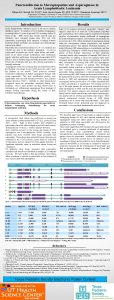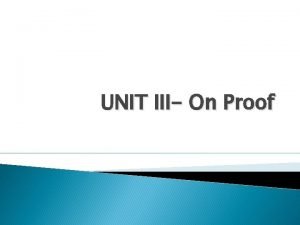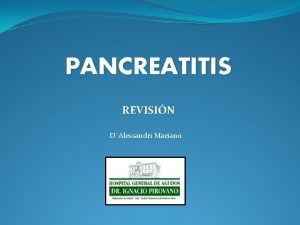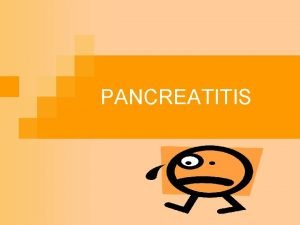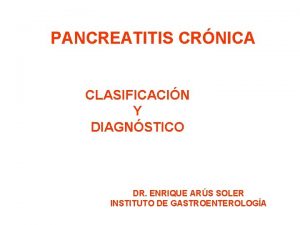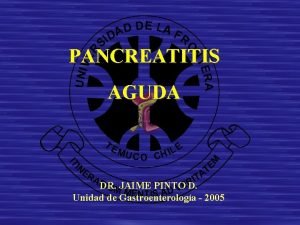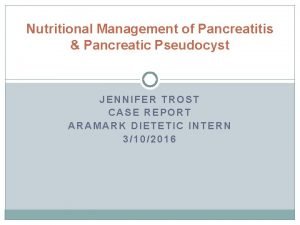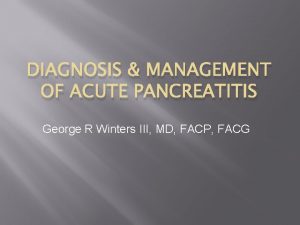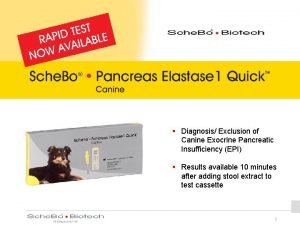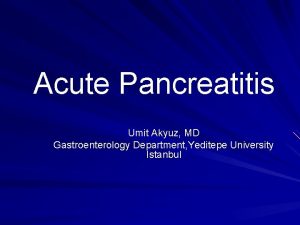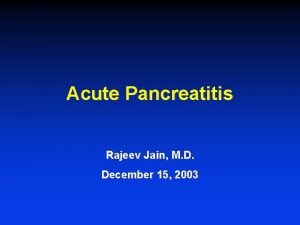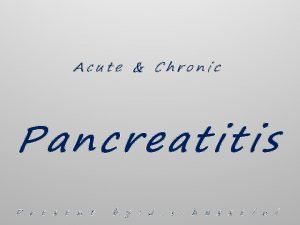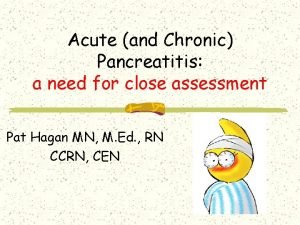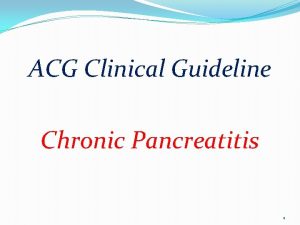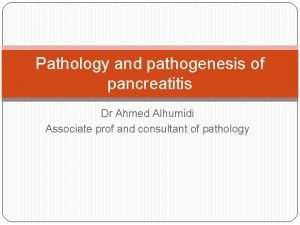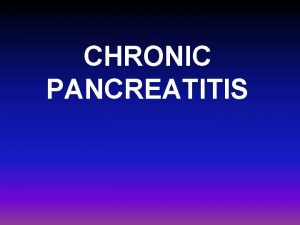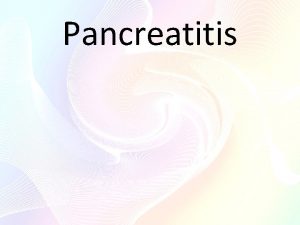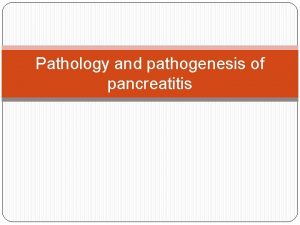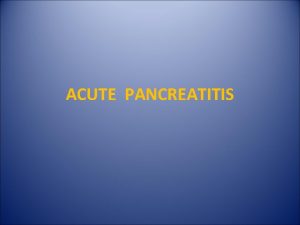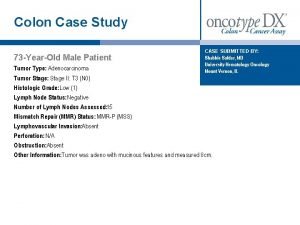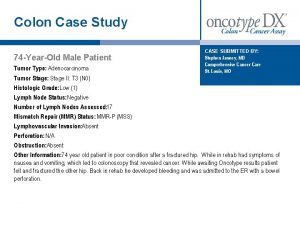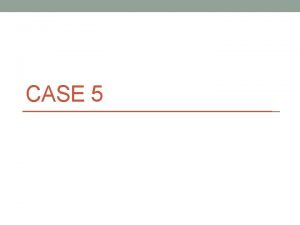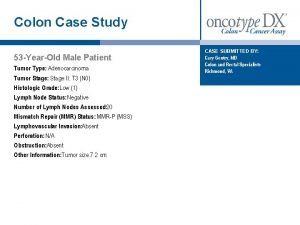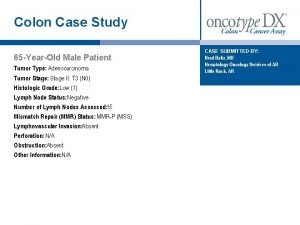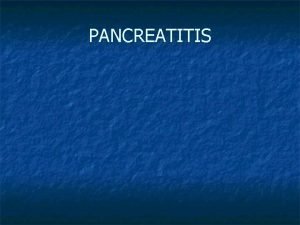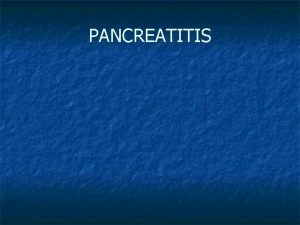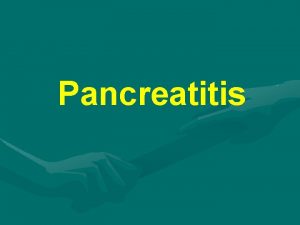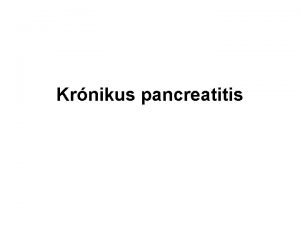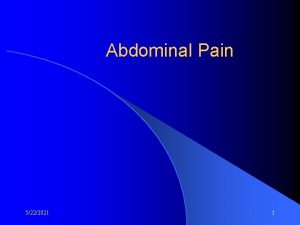Pancreatitis Case Study Situation 44 yearold male admitted






















- Slides: 22

Pancreatitis Case Study

Situation • • • 44 year-old male admitted to med-sug c/o nausea, vomiting, and abdominal pain Sudden onset of pain in RUQ last night Waited a few hours before seeking tx Was given 4 mg Morphine IV 15 minutes ago

Background • • Hx of substance abuse Has been in rehab for both ETOH and drug abuse Currently using ETOH and meth despite prior tx Unemployed, works in construction Lives with girlfriend Divorced and sees his two kids occasionally No other chronic medical issues

Assessment • • Thin and disheveled Anxious and restless Temp-99, RR 24, HR 100, BP 140/70, Sat 96% on RA Diffuse tenderness of abdomen Lungs clear, HRR, no edema Skin with acniform lesions Poor dentition No relief from pain despite medication You call MD for additional pain med orders

Why is the pain med not effective? His history of opioid abuse has desensitized him Is he still at risk for respiratory depression? Yes!

Response • Dilaudid (hydromorphone) 2 mg IV q 2 hours prn moderate pain (3 -6/10) • Dilaudid 4 mg IV q 2 hours prn severe pain (710/10) • Ondansetron 4 mg IV q 6 hours prn N/V • Labs: CBC, Chem panel, lipase, amylase • DI: abdominal ultrasound

Lab Results • • • WBC= 14 Potassium = 3. 3 Sodium =135 Glucose = 85 Lipase = 1300 (normal < 160) Amylase = 600 ( normal 25 -85)

CT findings

Acute Pancreatitis • inflammatory condition of the pancreas that is painful and at times deadly • mortality rate of acute pancreatitis is about 10% • The most common cause of acute pancreatitis is stones in the gallbladder Other causes are: q Ingested medicines q High triglyceride levels in the blood q High calcium levels in the blood q Heavy alcohol consumption

Symptoms • gradual or sudden pain in the upper abdomen that sometimes extends to the back • pain may be mild at first and become worse after eating • pain is often severe, constant, and commonly lasts for several days in the absence of treatment Other symptoms can include: – – Swollen and tender abdomen Nausea and vomiting Fever Rapid pulse

Question • What orders would you expect?

Answer • IV fluids to prevent dehydration and ensure that the rest of the organs of the body get adequate blood flow (perfusion) • Pain control • Control of nausea • Treatment of underlying causes (if any): – Gallstones – Medications – High Triglycerides

2 days later • Lipase and Amylase have dropped significantly • Clear liquid diet is ordered • Despite resolving symptoms patient still states his pain is 10/10 Why?

Next day • You have managed to wean him down to 0. 5 mg Dilaudid IV every 4 hours • Now patient is becoming disoriented and shaky What could patient’s current problem be?

Delirium Tremens (DTs) • Severe form of alcohol withdrawal • Involves sudden and severe mental or nervous system changes • Most patients have associated hallucinations • Between 1 -4% of patients with DT die: – Hyperthermia – Cardiac arrhythmias – Complications of withdrawal seizures

Symptoms caused by • extreme hyperactivity of the autonomic nervous system This leads to: – – – low-grade fever rapid breathing Tremor profuse sweating. Tonic-clonic seizures

TX of acute alcohol withdrawal • mainstay of the pharmacologic treatment of withdrawal delirium is depressants such as benzodiazepines • Ativan (Lorazepam) – Dosed according to alcohol withdrawal scale – Often doses much higher than you would normally give – Example: 2 mg IV every hour • Banana bag

3 days later • Patient is stabilized • Alcohol withdrawal symptoms have resolved • Tolerating a bland diet What are his discharge needs?

Does he need ETOH education? He probably knows more about ETOH cessation than you or I

Then why rehab? Keep him “dry” for an extended period of time Behavior modification Reinforcement Support group therapy

How do you feel about this case? • Failed repeated attempts at rehab • Living off government programs • Cost tax-payers six days of acute inpatient treatment

What are the primary ethical considerations in this scenario? Patient autonomy and the right to self-determination
 Asparaginase: pancreatitis in children: 2 case reports
Asparaginase: pancreatitis in children: 2 case reports A nurse floats to a busy surgical unit
A nurse floats to a busy surgical unit Admitted fact need not be proved
Admitted fact need not be proved Patient hospital admission
Patient hospital admission Best worst and average case
Best worst and average case Foxmeyer erp failure case study
Foxmeyer erp failure case study Study this example situation
Study this example situation Criterio baltazar
Criterio baltazar Escalas para pancreatitis
Escalas para pancreatitis Características de nutrición
Características de nutrición Criterios diagnosticos pancreatitis
Criterios diagnosticos pancreatitis Complicaciones de la pancreatitis
Complicaciones de la pancreatitis Pancreatic pseudocyst diet
Pancreatic pseudocyst diet Marshall pancreatitis
Marshall pancreatitis Pancreatitis atlanta criteria
Pancreatitis atlanta criteria Epi 4 dogs
Epi 4 dogs Atlanta criteria pancreatitis
Atlanta criteria pancreatitis Acute pancreatitis diagnosis criteria
Acute pancreatitis diagnosis criteria Gallstonee
Gallstonee Ransons criteria
Ransons criteria Acg chronic pancreatitis
Acg chronic pancreatitis Pathophysiology of acute pancreatitis
Pathophysiology of acute pancreatitis Pancreatitis alcohol
Pancreatitis alcohol
